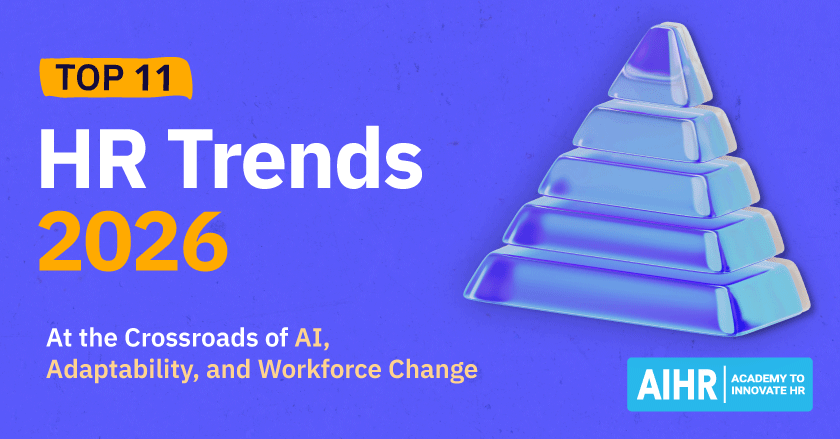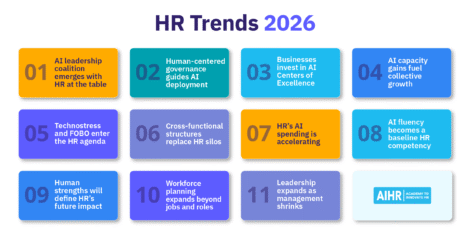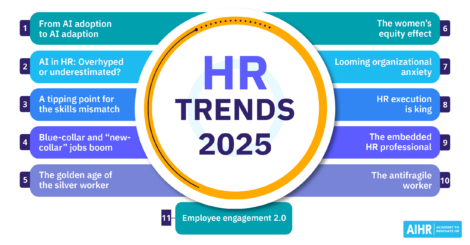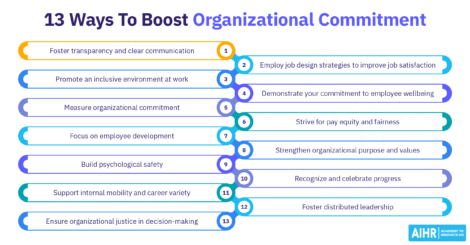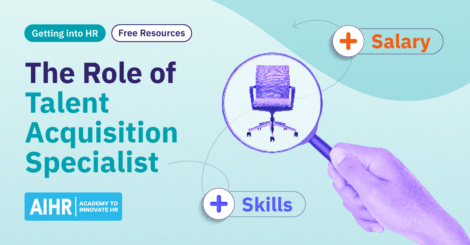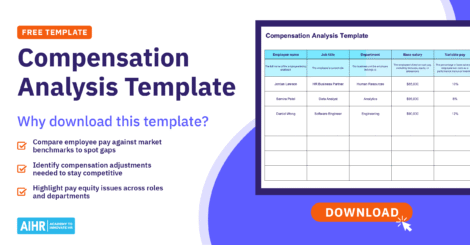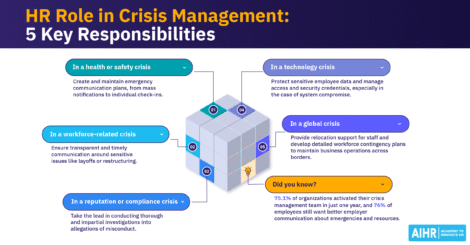The U.S. healthcare system faces challenges with rising costs, a growing uninsured population, and inconsistent care quality. Additionally, one in three healthcare workers plan to leave their jobs in a year, and 14% plan to leave the industry entirely.
At the same time, 73% of these workers feel underpaid, and 59% feel unappreciated at work. These challenges highlight the need for effective HR management to drive positive change and improve the healthcare system. As an HR professional, how can you develop an integrated approach to these challenges that aligns with broader healthcare goals and reforms?
Contents
What is HR in healthcare?
The role of HR in healthcare
HR challenges in healthcare
5 examples of Human Resource Management in healthcare
1. Jefferson Health
2. Mount Sinai Health System
3. AdventHealth
4. CVS Health
5. Walmart Health
What is HR in healthcare?
In healthcare, HR is vital for managing the workforce and supporting healthcare facility operations. HR recruits, hires, and trains healthcare professionals to ensure they have the skills and qualifications needed to provide high-quality care.
Additionally, HR handles employee relations, compensation and benefits, regulatory compliance, and strategic workforce planning. This includes managing staffing levels and training staff to keep them updated on the latest medical practices and technologies.
Through effective workforce management, HR helps healthcare organizations maintain a high standard of care while controlling costs and improving overall efficiency.
The role of HR in healthcare
Recruitment and staffing
One of HR’s roles in healthcare is recruiting and retaining skilled professionals like doctors, nurses, and technicians. HR sources, screens, and interviews candidates, managing the selection process to hire the most qualified individuals.
Additionally, HR develops retention strategies by offering competitive compensation and benefits packages, professional development opportunities, and career advancement paths.
Employee relations
HR plays an important role in handling employee relations, resolving conflicts, and boosting job satisfaction. In the high-stress healthcare setting, HR must actively address workplace stress, burnout and wellbeing.
By promoting mental and physical health through targeted programs, HR helps maintain staff morale, which is crucial for patient care standards and operational efficiency.
Regulatory compliance
As healthcare is highly regulated, HR must ensure compliance with all relevant laws and standards. This includes managing licensing, maintaining accurate records, and adhering to regulations on working hours, safety, and patient privacy.
HR conducts regular training and audits to keep the workforce informed and compliant, reduce legal risks, and ensure the organization operates within legal bounds.
HR tip
Invest in AI upskilling: As AI continues to impact healthcare, provide AI training across all roles to help reduce administrative burdens and prepare the workforce for future technological advancements. This helps also employees remain competitive and proficient.
Training and development
HR is responsible for continuously training and developing healthcare staff, ensuring they stay updated on the latest medical practices, technologies, and regulations. HR also helps develop training programs covering mandatory topics like compliance and safety.
Additionally, the HR department works with the organization to provide the workforce with professional development opportunities.
Workforce planning and management
HR’s role in workforce planning involves forecasting staffing needs based on factors like patient volume and seasonal trends, as well as ensuring adequate staffing levels. HR also manages shift scheduling and workload distribution, which helps prevent staff shortages, reduce employee burnout, and ensure timely patient care.
Compensation and benefits
HR designs and manages compensation and benefits programs that attract and retain top talent. This includes developing competitive salary structures, managing benefits like health insurance and retirement plans, and aligning these with industry standards and the organization’s operating budget.
Employee health and safety
HR is responsible for policies and procedures that create a safe working environment. This includes managing occupational health programs, ensuring compliance with safety regulations, and training staff to handle hazards. HR also oversees wellness programs and injury prevention strategies, promoting overall health and lowering workplace injury risk.
HR in healthcare courses
As an HR professional in the healthcare field, attending courses can help you and your organization’s workforce by enhancing your HR skills and knowledge. Here are some options:
- AIHR’s certificate programs: Although not specific to healthcare, these certificate programs can help HR professionals upskill in specific areas. Examples include Strategic Talent Acquisition, Sourcing & Recruitment, and Workplace Health and Wellbeing.
- Study.com: Human Resource Management in Healthcare.
- NYU Wagner: Principles of Human Resources Management for Healthcare Organizations.
- Harvard University: Innovations in Teamwork for Health Care.
- Oxford Management Centre: Human Resource Management for Healthcare Professionals.
HR challenges in healthcare
There are several challenges that HR professionals in the healthcare field are impacted by:
- High turnover rates: Particularly common among nurses and support staff, high employee turnover rates lead to staffing shortages, increased workload, and patient care disruptions.
- Hiring difficulties: The specialized skills and qualifications many roles demand make hiring in healthcare incredibly challenging. Demand often exceeds supply, making it difficult to attract and hire the right talent.
- Regulatory compliance: Healthcare is a highly regulated industry, with strict, complex laws on patient care, employee safety, and data privacy (among others) that often change. This makes it challenging for HR to guarantee compliance with these regulations.
- Mental and physical burnout: Healthcare’s high-stress environment often results in emotional and physical burnout. HR must address and mitigate this to ensure staff wellbeing and avoid strikes that affect healthcare services.
- Workforce shortages: Employee shortages in healthcare are common, especially in rural or underserved areas. HR must find ways to manage these shortages, such as cross-training programs or temporary staffing solutions.
- Diversity, Equity, Inclusion, and Belonging (DEIB): HR must develop a workforce that reflects the diverse patient populations it serves.
- Technology integration: As healthcare increasingly relies on advanced technology, HR must ensure that staff are adequately trained to use new systems and tools. This includes managing the transition to electronic health records (EHRs), telemedicine platforms, and other digital innovations.
- Budget constraints: Limited budgets in healthcare can impact HR’s ability to offer competitive salaries, attractive benefits, and effective training programs. HR must balance attracting and retaining top talent with the industry’s financial realities.
- Employee health and safety: Healthcare workers face a higher risk of infectious diseases, workplace injuries, and other health hazards. HR must implement robust health and safety protocols, provide appropriate personal protective equipment (PPE), and offer training on minimizing workplace risks.
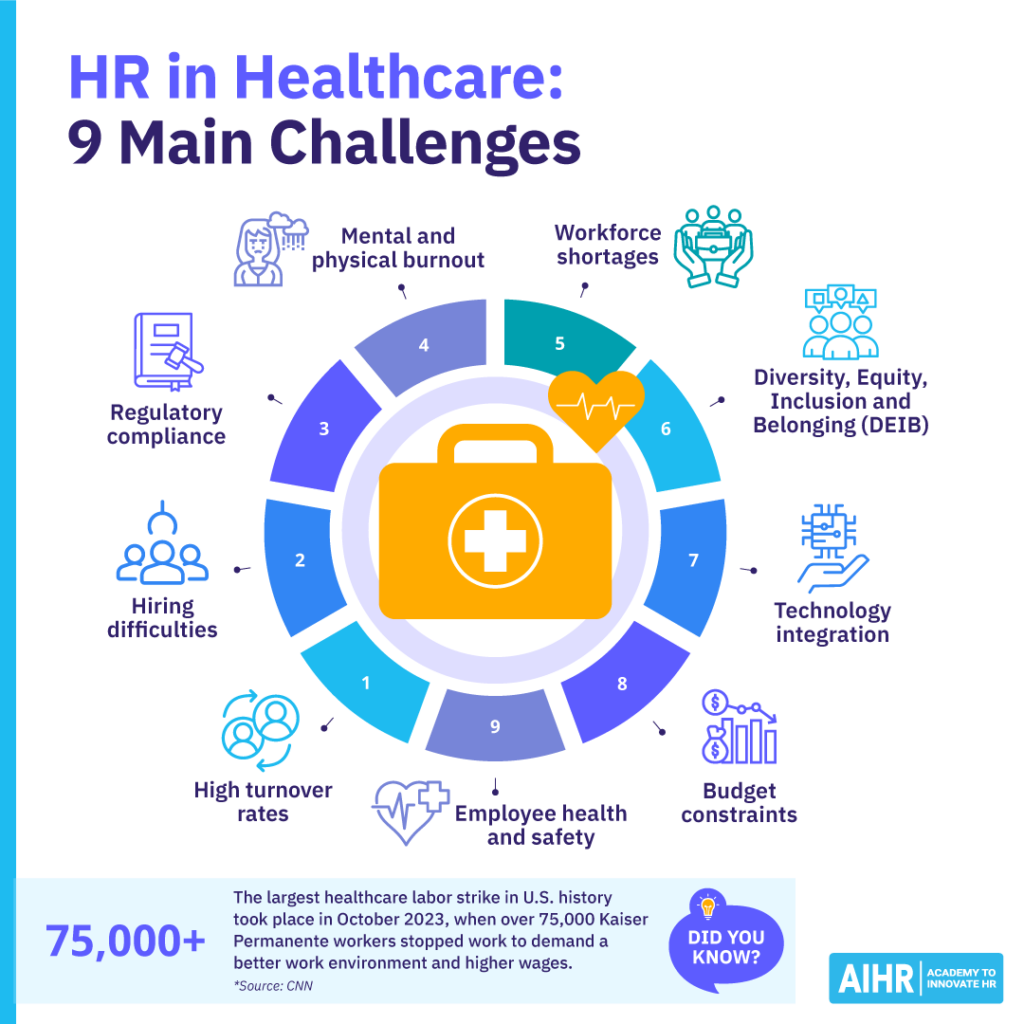
How HR can manage these challenges
High turnover rates
Implement recognition initiatives, career development plans, and mentorship opportunities to increase employee engagement and retention. At the same time, offer competitive compensation and benefits, and regularly review and adjust compensation packages, (including performance bonuses and comprehensive benefits).
Hiring difficulties
Leverage technology in your recruitment methods to make hiring easier and more effective. Use applicant tracking systems (ATS) and AI-driven tools to streamline hiring and identify qualified candidates more efficiently.
You can also advise your organization to develop partnerships. These can include collaborations with educational institutions to create pipelines for new graduates through internships and residency programs.
HR tip
Focus on skills-based hiring and internal mobility: A skills-based hiring approach widens the talent pool, promotes diversity, and helps your organization find candidates who meet evolving healthcare demands. Additionally, encouraging internal mobility allows employees to grow within the organization, improving retention and reducing recruitment costs.
Compliance and regulations
Implement regular training and audits to update staff on regulatory requirements and ensure compliance. Monitor healthcare law and regulation changes through industry newsletters, networks, and conferences.
Emotional and physical burnout
Focus on total wellbeing. Introduce wellness initiatives, mental health resources, and stress management workshops, and encourage peer support networks. Also, offer flexible work schedules, shift rotations, and opportunities for time off to help manage work-life balance and reduce burnout.
Workforce shortages
Implement cross-training programs to equip staff to perform multiple roles and fill gaps during workforce shortages. You can also integrate telemedicine and remote work options wherever possible to extend healthcare services without overburdening staff.
Diversity, Equity, Inclusion, and Belonging
Promote an inclusive culture through diversity programs to reinforce respect and belonging among staff. Minimizing the risk of bias in your hiring practices will also help promote Diversity, Equity, Inclusion, and Belonging (DEIB).
Diverse recruitment strategies are also important. Actively recruit from diverse backgrounds by advertising in different communities and partnering with organizations that support minority groups.
Technology integration
Provide continuous training on new technologies and offer support to ensure staff are comfortable and proficient with new tools. Be sure also to introduce new technologies and systems in phases to allow time for adaptation and provide resources like user manuals and support hotlines.
Budget constraints
Practice strategic budgeting. Prioritize spending on training, safety, and benefits. You can also consider offering non-monetary perks or negotiating group discounts. At the same time, explore grants, subsidies, and other funding opportunities to offset training and technology upgrade costs.
Employee health and safety
Develop and enforce robust safety protocols tailored to healthcare settings, regularly updating them and conducting safety drills. Additionally, ensure access to necessary personal protective equipment (PPE) and provide proper training, maintaining open communication to address safety concerns.
HR tip
Ensure financial wellness for aging employees: As the healthcare workforce ages, financial wellness programs are more important than ever. Providing retirement planning resources and financial counseling offers employees security. It also enhances the organization’s reputation for valuing and supporting experienced healthcare workers throughout their careers.
5 examples of Human Resource Management in healthcare
Here are five real-life examples of strategic HR management in healthcare you can use to inform the development of your own strategy for your organization:
1. Jefferson Health
Jefferson Health integrates strategic HR management (SHRM) into its overall business strategy. The organization conducts thorough environmental scans to identify industry trends and challenges, such as the rising demand for specialized healthcare services.
It then develops HR strategies aligned with its organizational goals, equipping its workforce to meet future demands. This includes involving key stakeholders in the strategy formulation process and regularly evaluating its HR initiatives to make continuous improvements.
2. Mount Sinai Health System
Mount Sinai has adapted to technological advancements by incorporating technology-focused staff training. This is crucial in an era where telehealth and other digital tools are integral to patient care.
Mount Sinai also keeps up with regulatory changes through a dedicated compliance team that updates HR policies and staff training based on the latest regulations. This helps the organization maintain high standards of care while navigating healthcare’s complex regulatory environment.
3. AdventHealth
AdventHealth prioritizes aligning HR strategies with its mission to extend healing services. The organization involves key stakeholders in developing HR strategies to ensure they support its mission and strategic goals.
In doing so, it creates a cohesive work environment that ties HR initiatives with the organization’s broader objectives and unites and motivates its workforce.
4. CVS Health
After acquiring Oak Street Health, CVS Health expanded its primary care service line, particularly for Medicare beneficiaries in underserved communities.
This has had significant HR implications. The organization must integrate a large number of new employees into its workforce while ensuring regulatory compliance and continuing to deliver high-quality care across its expanded network.
5. Walmart Health
Walmart has made significant strides in healthcare by growing its network of health clinics. With over 30 sites and plans to expand further, Walmart Health aims to provide affordable healthcare services in underserved areas.
HR plays a crucial role in this expansion, recruiting and training healthcare professionals and ensuring each clinic has enough qualified personnel to meet the community’s needs.
To sum up
In healthcare, HR is responsible for recruiting, hiring, and training healthcare professionals. HR must also oversee employee relations, compensation, benefits, regulatory compliance, and workforce planning. Managing these functions helps sustain high standards of patient care while optimizing efficiency and controlling costs.
However, HR in healthcare also faces significant challenges, such as high turnover, hiring difficulties, workforce shortages, new technologies, and budget constraints. As such, HR must implement strategic initiatives, such as recruitment technology, cross-training programs, and robust employee health and safety protocols.
As an HR professional in healthcare, you can benefit yourself and your workforce with continuous professional development through specialized courses and certificate programs.




